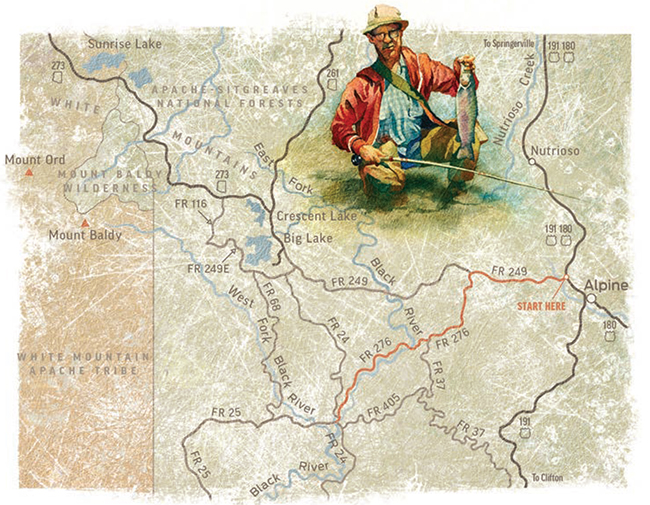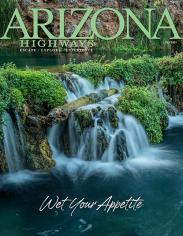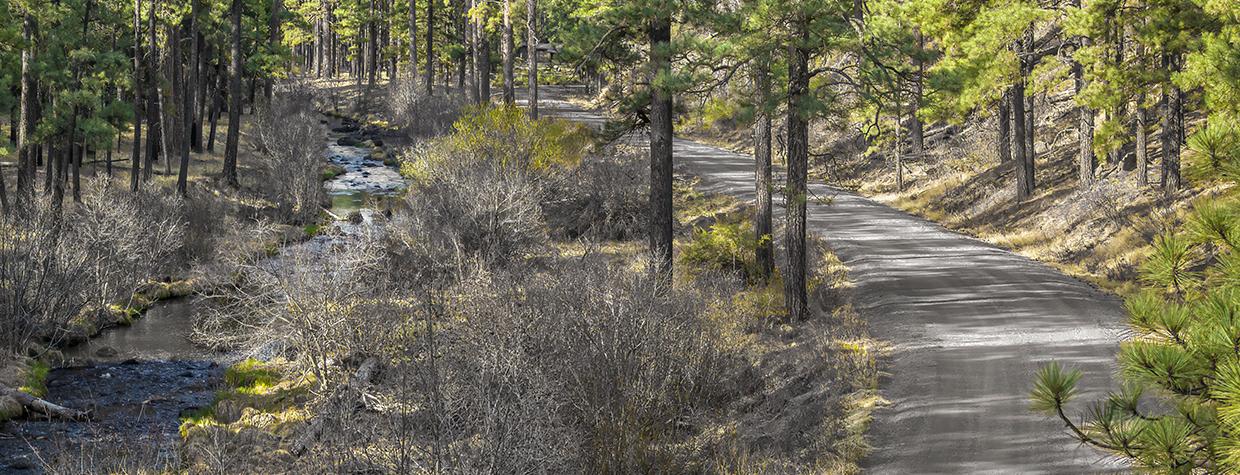There might not be a silver lining to wildfire, but there’s a white (and black) one: aspens, which colonize burned areas in many of Arizona’s forests. You’ll see ample evidence of that along Forest Road 276, which meanders through areas scorched by the 2011 Wallow Fire en route to the East Fork of the Black River. As you’ll find on this trek, that blaze and its aftermath have brought a new form of beauty to the White Mountains of Eastern Arizona.
This drive starts near the small town of Alpine; just northwest of there, head west on Three Forks Road (Forest Road 249), an Apache-Sitgreaves National Forests route that was paved in 2014 and forms a scenic link between the Alpine area and Big Lake. Tall ponderosa pines and other evergreens line the road and a series of seemingly endless meadows, a hallmark of this part of Arizona’s high country.
After 5.3 miles, you’ll leave the pavement by turning left onto FR 276, a gravel route that climbs into a rolling landscape where young aspens are springing up to replace the conifers felled by Wallow. According to the U.S. Forest Service, as many as 10,000 aspens can sprout on a single acre after a wildfire, but after 20 or 30 years, the trees thin themselves out and number about as many as they did before the fire. Until then, these aspens are enjoying their time in the sun.
The early, mostly smooth miles of FR 276 feature a patchwork of burned and unburned areas as the road eases downhill toward the river. At Mile 8, you’ll pass through another expansive grassland dotted with pines, and a couple of miles later, the road begins a steeper descent. With that change comes a much rougher roadway, and from miles 10.5 to 11.5, you might wonder whether the remainder of the drive will be this bumpy. Thankfully, it won’t, and assuming you reach the bottom without rattling loose any bolts (or fillings), it’s smooth sailing the rest of the way.
Just after the end of the hill, you’ll enter the East Fork Recreation Area, a Forest Service site that encompasses numerous campgrounds, picnic tables and day-use areas for enjoyment of its namesake waterway. You’ll first pull alongside the East Fork, on the right, at Mile 12, in an idyllic riparian area under a burned canyon wall. Past that is a one-lane bridge over the river, and for the rest of the drive, the water will be on the left side of the road.
Much of the remainder of FR 276 follows what, by now, is a familiar pattern: glimpses of burned trees (and countless aspens) between verdant stretches of river and ponderosa forest. But that doesn’t mean you shouldn’t follow it to its conclusion. This is bighorn sheep country, and it’s not uncommon to see a herd of those ungulates gathering along the road — or sunning themselves in the middle of it. Other surprise visitors could include pronghorns, mule deer or a variety of waterfowl.
At Mile 16, the road briefly climbs away from the river before rejoining it, and it’s only a couple of miles from there to where FR 276 ends at an intersection with forest roads 24 and 25. You can take these roads to Big Lake, the river’s West Fork or other White Mountains destinations. But maybe, for a different perspective on the same area you just explored, you should go back the way you came. After all, most of those aspens won’t be around too long.

Tour Guide
Note: Mileages are approximate.
Length: 18.3 miles one way (from U.S. Route 180)
Directions: From U.S. Route 180 about 2 miles northwest of Alpine, go west on Three Forks Road (Forest Road 249) for 5.3 miles to Forest Road 276. Turn left (south) onto FR 276 and continue 13 miles to the road’s end.
Vehicle Requirements: A high-clearance vehicle, such as an SUV or truck, is recommended, but four-wheel-drive is not necessary in good weather. The route is impassable during high-water periods, so do not attempt the drive after recent heavy rain or if rain is in the forecast.
Warning: Back-road travel can be hazardous, so be aware of weather and road conditions. Carry plenty of water. Don’t travel alone, and let someone know where you are going and when you plan to return.
Information: Alpine Ranger District, 928-339-5000 or fs.usda.gov/asnf
Travelers in Arizona can visit www.az511.gov or dial 511 to get information on road closures, construction, delays, weather and more.

